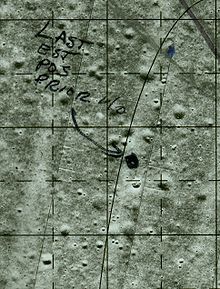Use of writing implements in space travel
The use of writing implements in space travel takes place under the conditions of weightlessness and possibly a vacuum .
Conventional writing implements
Various types of pencils , copier pens, and ink pens have been used throughout the history of space travel . Some of them were unmodified versions of commercially available writing implements , others were specially developed for space flights.
The wooden pencil was initially used by both Soviet cosmonauts and American astronauts. The pencil's simplicity and the immobility of its components spoke in favor of the pencil. However, both wood and the graphite contained in pencil leads and the rubber of erasers are flammable and they all generate dust that floats through the room in weightlessness, can be inhaled and ignite. Graphite is also an electrical conductor and can cause short circuits.
Mechanical pencils have been used by NASA since the Gemini program in the 1960s. Its width can be adapted to the width of the astronaut gloves. Mechanical pencils saved combustible wood, but graphite dust was still released. The Soviet cosmonauts used plastic-coated grease pencils as early substitutes for wooden pencils. These pens had the advantage of being simple and rigid, so they were hardly prone to defects. A disadvantage is the faster fading of the writing compared to ink.
Ballpoint pens were used by Soviet and later Russian space missions as well as by NASA and ESA. The pens were inexpensive, their writing lasted longer than that of pencils and grease pencils, making them more suitable for logbooks and scientific notes. However, ballpoint pen ink cannot be erased and conventional ballpoint pens require the ink to flow down for the pen to write.
Felt pens were used by NASA astronauts on the Apollo missions. By capillary action to guide the writing fluid under gravity into the tip.
Special developments
The Space Pen is a gas-pressurized ballpoint pen that is very robust and works under a variety of external conditions, including weightlessness, vacuum and extreme temperatures. It was used by NASA astronauts on Apollo, Shuttle and ISS missions.
Trivia
One of the modern legends is the story that NASA had the space pen developed for a large amount of money especially for its space missions in order to have a ballpoint pen that writes in weightlessness, while the Soviet cosmonauts generally used pencils. In fact, the pen was not developed on behalf of and without any financial support from NASA. In Germany, this rumor was fueled, among other things, by the incorrect reporting by ARD on the moon landing , as one of the moderators in the television studio told the story. After 2006, a commercial for the newspaper Handelsblatt gave the saga a new spread.
Web links
- Zeit Online: Writing in Space (from: Isn't that right? March 2, 2006)
- Scientific American: "Fact or Fiction ?: NASA Spent Millions to Develop a Pen did Would Write in Space, Whereas the Soviet Cosmonauts Used a Pencil" (English)
- ESA: Pedro Duque's diary from space (English)
Individual evidence
- ↑ Landing Site Maps / Images. In: Apollo Lunar Surface Journal. NASA, accessed on April 11, 2012 (English): "Mike Collins marked a number of locations with combinations of lines, arrows, circles, and one ellipse using either pencil or a felt-tipped pen"
- ↑ The billion-dollar space pen , by Dwayne A. Day (Engl.)
- ↑ BBDO Germany "Space Pen" Spot of the Year ( Version from September 27, 2007 ( Memento from September 29, 2007 in the Internet Archive ))
